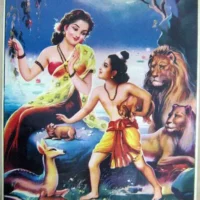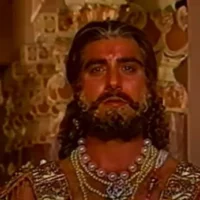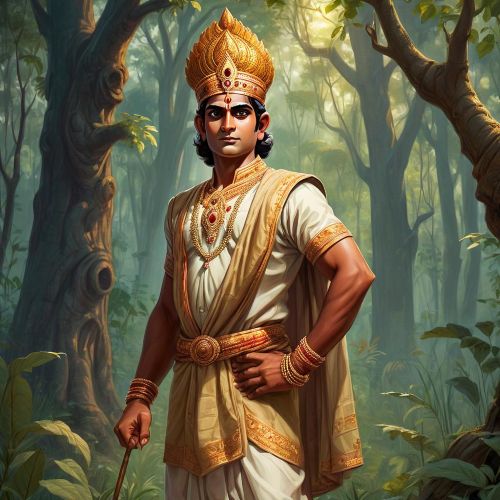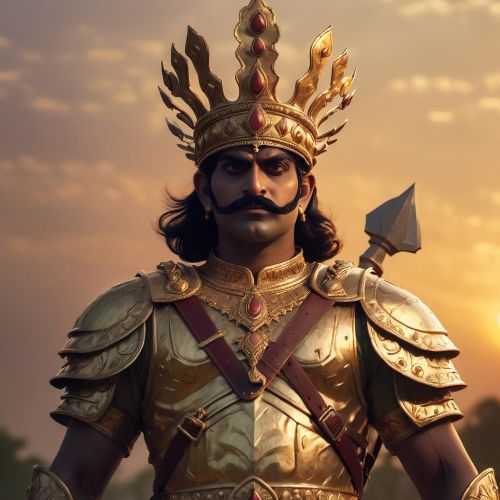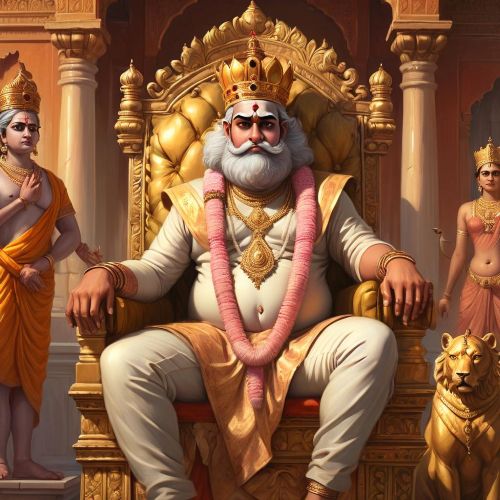Bharata : The Legendary Emperor
Listen
At a glance
| Description | |
|---|---|
| Origin | Indian Mythology |
| Classification | Mortals |
| Family Members | Dushyanta (Father), Shakuntala (Mother), Sunanda (Wife), Bhumanyu (Son) |
| Region | Indian |
| Associated With | Royalty, Righteousness, Honesty |
Bharata
Introduction
Bharata, the legendary emperor celebrated in Indian mythology, is remembered as one of the greatest rulers of ancient times and the namesake of the Indian subcontinent—Bhārata. His story is primarily told in the Mahabharata, where he emerges as a Chakravarti, a universal monarch whose power extended across vast territories. In literature, his life was also immortalized in Kalidasa’s Abhijñānashākuntala, which depicts both his royal lineage and his destiny. Bharata’s significance lies not just in his military conquests or political achievements, but in his role as the symbolic ancestor of the Pandavas and Kauravas, shaping the historical and cultural narrative of India for thousands of years.
Physical Traits
From birth, Bharata was marked by signs of greatness. He was said to have the unmatched strength of 10,000 elephants, a physical gift that set him apart even in childhood. His fearlessness was legendary—tales recount him engaging with wild animals without hesitation, displaying the kind of authority and composure that would later define his rule. His birth name, Sarvadamana, meaning “subduer of all,” reflected this unmatched courage. A sacred chakra mark on his right hand symbolized divine sanction, affirming his role as a ruler destined to conquer and unite realms under a single authority. Such descriptions of his physique and presence portray him as the ideal embodiment of royal power and divine favor.
Family
Bharata’s heritage brought together both mortal and celestial bloodlines. He was the son of King Dushyanta and Shakuntala, whose love story remains one of the most cherished narratives in Sanskrit literature. Shakuntala herself was the daughter of the heavenly nymph Menaka and the sage Vishvamitra, making Bharata a product of royal and divine ancestry. Initially, Dushyanta’s doubt over his paternity cast a shadow on Bharata’s early years, but a heavenly voice confirmed his legitimacy, restoring his rightful place in the royal lineage. His marriage to Sunanda, a princess of Kashi, strengthened his political alliances. Though accounts differ, many sources mention that his biological sons were deemed unfit to rule, leading him to adopt Bhumanyu, either through divine intervention or the guidance of sages. This decision revealed his commitment to choosing a worthy successor over following hereditary norms, reinforcing his dedication to righteous governance.
Other names
Bharata is known by several names, each carrying layers of meaning tied to different stages of his life and accomplishments. His childhood name, Sarvadamana, captured his fearlessness and strength. Following his ascension and conquests, he came to be widely recognized simply as Bharata—a name that would become a cornerstone of India’s identity. Titles like Digvijaya Chakravartin emphasized his role as a ruler whose conquests spanned the four directions, while Samrāj underscored his status as the emperor of emperors. In later Puranic traditions, the name Jada Bharata was used to describe a later spiritual incarnation of Bharata, focused on renunciation and enlightenment. Above all, the name Bhārata became synonymous with the Indian nation itself, enshrined in the Constitution of India as a testament to his lasting influence.
Powers and Abilities
Bharata’s powers encompassed both martial dominance and spiritual insight. Militarily, he expanded his realm through campaigns that established him as an unrivaled force. The Mahabharata recounts his performance of grand sacrifices—1,800 Ashwamedha Yagnas, 100 Rajasuya Yagnas, and numerous Vajapeya rituals—acts that not only demonstrated his political supremacy but also reinforced his spiritual authority. His reign was marked by wealth, order, and the protection of dharma. Yet his abilities extended beyond the battlefield. In later traditions, the figure of Jada Bharata embodies his pursuit of detachment and self-realization, a profound shift from conquest to contemplation. His ability to move from power to renunciation showed a rare balance between temporal authority and spiritual liberation, underscoring why he is remembered as both a conqueror and a sage.
Modern Day Influence
The influence of Bharata continues to resonate in modern India, most tangibly in the nation’s very name, Bhārata, which stands alongside “India” as an official designation in the Constitution. This enduring tribute connects the cultural memory of an ancient ruler to the identity of a modern republic. His reign, characterized by unity without suppressing diversity, mirrors the principles on which the Indian state is built today—embracing multiple languages, faiths, and traditions under one national framework.
In literature and the arts, Bharata’s story remains a source of inspiration. The dramatic retelling of his parents’ romance in Abhijñānashākuntala has been adapted into countless plays, films, and television series, keeping the tale alive for new generations. Philosophically, his choice to prioritize merit over lineage in succession is often cited in discussions of ethical governance. His symbolic association with dharma, justice, and responsible rulership still informs political thought and public discourse in India. From the pages of ancient epics to modern classrooms and cultural festivals, Bharata remains a touchstone for ideals of leadership, integrity, and national pride.
Related Images
Source
Wikipedia contributors. (2023). Bharata (Mahabharata). Wikipedia. https://en.wikipedia.org/wiki/Bharata_(Mahabharata)
Vedicfeed. (2023, July 4). The Story of King Bharata and His Incarnations. https://vedicfeed.com/king-bharata/
Britannica. (n.d.). Bharata Hindu mythology. https://www.britannica.com/topic/Bharata-Hindu-mythology
Economic Times. (2023). India, that is Bharat: The origin and meaning of the ancient name. https://economictimes.indiatimes.com/news/india/india-that-is-bharat-the-origin-and-meaning-of-the-ancient-name/articleshow/103401596.cms
Philosophy Institute. (n.d.). Bharata’s Natyasastra: The Bedrock of Indian Aesthetic Theory. https://philosophy.institute/aesthetics/bharatas-natyasastra-indian-aesthetic-theory/
HinduKarma. (2024). Bharata’s Role and Values in Ramayana: A Deep Analysis. https://hindukarma.com/bharatas-role-and-values-in-ramayana-a-deep-analysis/
Bambinos Faculty. (n.d.). Bharata: The Unsung Hero in the Ramayan. https://faculty.bambinos.live/blog/bharata-the-unsung-hero-in-the-ramayan
Telangana Today. (2023). From Meluha to India, the many names of ‘Bharat’ across centuries. https://telanganatoday.com/from-meluha-to-india-the-many-names-of-bharat-across-centuries
Wikipedia contributors. (2023). Names for India. Wikipedia. https://en.wikipedia.org/wiki/Names_for_India
Mythology Worldwide. (n.d.). The Mahabharata: The Influence of Myth on Modern Society. https://hindu.mythologyworldwide.com/the-mahabharata-the-influence-of-myth-on-modern-society/
Frequently Asked Questions
What is lorem Ipsum?
I am text block. Click edit button to change this text. Lorem ipsum dolor sit amet, consectetur adipiscing elit. Ut elit tellus, luctus nec ullamcorper mattis, pulvinar dapibus leo.
What is lorem Ipsum?
I am text block. Click edit button to change this text. Lorem ipsum dolor sit amet, consectetur adipiscing elit. Ut elit tellus, luctus nec ullamcorper mattis, pulvinar dapibus leo.
What is lorem Ipsum?
I am text block. Click edit button to change this text. Lorem ipsum dolor sit amet, consectetur adipiscing elit. Ut elit tellus, luctus nec ullamcorper mattis, pulvinar dapibus leo.
What is lorem Ipsum?
I am text block. Click edit button to change this text. Lorem ipsum dolor sit amet, consectetur adipiscing elit. Ut elit tellus, luctus nec ullamcorper mattis, pulvinar dapibus leo.
What is lorem Ipsum?
I am text block. Click edit button to change this text. Lorem ipsum dolor sit amet, consectetur adipiscing elit. Ut elit tellus, luctus nec ullamcorper mattis, pulvinar dapibus leo.



